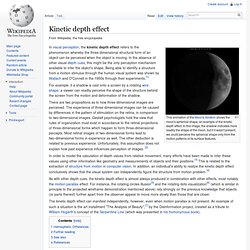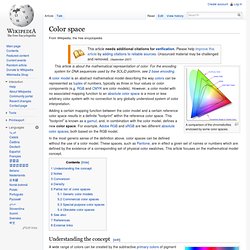

Kinetic depth effect. This animation of the Moon's libration shows the moon's spherical shape, an example of the kinetic depth effect.

In this image, the shadow indicates more readily the shape of the moon, but if it wasn't present, we could perceive the spherical shape only from the motion patterns of its surface features. In visual perception, the kinetic depth effect refers to the phenomenon whereby the three-dimensional structural form of an object can be perceived when the object is moving. In the absence of other visual depth cues, this might be the only perception mechanism available to infer the object's shape.
Being able to identify a structure from a motion stimulus through the human visual system was shown by Wallach and O'Connell in the 1950s through their experiments.[1] For example, if a shadow is cast onto a screen by a rotating wire shape, a viewer can readily perceive the shape of the structure behind the screen from the motion and deformation of the shadow. Hemispheric Differences[edit] Structure from motion. Structure from motion (SfM) is a range imaging technique; it refers to the process of estimating three-dimensional structures from two-dimensional image sequences which may be coupled with local motion signals.

It is studied in the fields of computer vision and visual perception. In biological vision, SfM refers to the phenomenon by which humans (and other living creatures) can recover 3D structure from the projected 2D (retinal) motion field of a moving object or scene. Obtaining 3D information from 2D images[edit] Real photo x SfM with texture color x SfM with simple shader. Made with Python Photogrammetry Toolbox GUI and rendered in Blender with Cycles. Humans perceive a lot of information about the three-dimensional structure in their environment by moving through it. Finding structure from motion presents a similar problem as finding structure from stereo vision. See also[edit] Further reading[edit] Richard Hartley and Andrew Zisserman (2003). References[edit]
Image gradient. Two types of gradients, with blue arrows to indicate the direction of the gradient.

Dark areas indicate higher values An image gradient is a directional change in the intensity or color in an image. Image gradients may be used to extract information from images. In graphics software for digital image editing, the term gradient or color gradient is used for a gradual blend of color which can be considered as an even gradation from low to high values, as used from white to black in the images to the right. Another name for this is color progression. Since the intensity function of a digital image is only known at discrete points, derivatives of this function cannot be defined unless we assume that there is an underlying continuous intensity function which has been sampled at the image points. The Sobel operator represents a rather inaccurate approximation of the image gradient, but is still of sufficient quality to be of practical use in many applications. Computer vision[edit] Math[edit] Color space. A comparison of the chromaticities enclosed by some color spaces.

A color model is an abstract mathematical model describing the way colors can be represented as tuples of numbers, typically as three or four values or color components (e.g. RGB and CMYK are color models). However, a color model with no associated mapping function to an absolute color space is a more or less arbitrary color system with no connection to any globally understood system of color interpretation.
Adding a certain mapping function between the color model and a certain reference color space results in a definite "footprint" within the reference color space. This "footprint" is known as a gamut, and, in combination with the color model, defines a new color space. In the most generic sense of the definition above, color spaces can be defined without the use of a color model. Understanding the concept[edit] A comparison of RGB and CMYK color models.
Notes[edit] Conversion[edit] Density[edit]